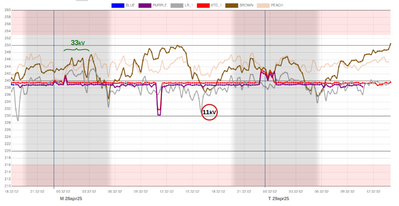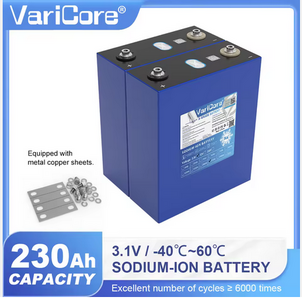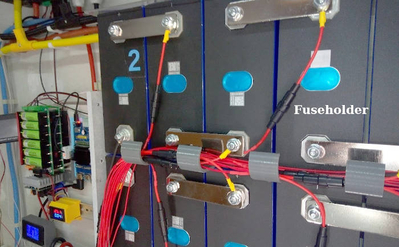@jamespa jumping on this thread late, and I'm of a similar opinion to you, I've been getting quotes every few years for a battery.
The payback has gone from none whatsoever, to marginal. Prices have stayed fairly static, while capacity (including depth of discharge), power, warranty and safety have improved, so better value overall.
I'm hopeful that the newer Sodium Ion chemistry launched by BYD for their small affordable domestic car market may soon find it's way into stationery battery storage.
In theory that could mark the point at which home batteries become really affordable, even safer, and work in the cold without heaters etc. 🤞
Posted by: @scalextrix@jamespa jumping on this thread late, and I'm of a similar opinion to you, I've been getting quotes every few years for a battery.
The payback has gone from none whatsoever, to marginal. Prices have stayed fairly static, while capacity (including depth of discharge), power, warranty and safety have improved, so better value overall.
I'm hopeful that the newer Sodium Ion chemistry launched by BYD for their small affordable domestic car market may soon find it's way into stationery battery storage.
In theory that could mark the point at which home batteries become really affordable, even safer, and work in the cold without heaters etc. 🤞
Im also hopeful that prices will come down but it does seem very slow. Im currently getting a quote once more, but its still working out at £400-500/kWh installed, which is still too much once you account for loss of interest on the capital, and tax on the revenue from arbitrage (sorry but I don't like building a business case on an assumption of tax avoidance)
Im also hopeful that bi directional EV chargers will return to the market, so I can replace our second car, a petrol Fiesta which spends almost all of its life on the driveway, with an aging Nissan Leaf that then doubles as a massive home storage battery.
Finally there is another revenue stream which Capture Energy are beginning to tout and Octopus will surely offer. If you can guarantee availability to either consume or produce 1MW or above, you can be paid an availability fee by the grid for flexibility, and a further fee if that flexibility is actually used. Individuals obviously cant do this, but 'virtual power companies' can, by aggregating many consumer sources. Sharing the revenue from this with the virtual power company provides an additional income stream which has the potential to help with the business case.
its very interesting times for sure
4kW peak of solar PV since 2011; EV and a 1930s house which has been partially renovated to improve its efficiency. 7kW Vaillant heat pump.
Posted by: @scalextrixI'm hopeful that the newer Sodium Ion chemistry launched by BYD for their small affordable domestic car market may soon find it's way into stationery battery storage.
I would be surprised if the battery chemistry is going to be a major factor in your viability assessment.
The major costs are
- installation time, incl tooling
- the inverter(s), cabling, safety trips etc
- training, certification, insurance & warranties
Let's combine this observation with the next comment from James:
Posted by: @jamesparevenue stream which Capture Energy are beginning to tout and Octopus will surely offer. If you can guarantee availability to either consume or produce 1MW or above, you can be paid an availability fee by the grid for flexibility
This is therefore an attractive path to be taken by local Community Energy groups.
The RIIO-ED2 Agreements between DNOs and Ofgem all have variations, but they do contain financial incentives for DNOs to
- engage with, and provide support to Community Energy initiatives
- offer flexibility-services
But DNOs may not own or control generation or storage assets.
They would, however, be 'interested' in Community Groups who could get their act together and do their own low-cost (semi-DIY) battery installations.
The more widespread were those storage batteries, the greater flexibility could be 'offered' back to that DNO.
The three key issues they're interested in are:
- absorbing excess-generation from renewable generation sites in the area (typically connected at 11kV or 33kV)
- time-slicing use of the (extensive) 11kV network so as to better use its available capacity over each day/night
- varying the charge current being taken from the grid such that losses due to phase-imbalance are progressively reduced
OK... so that requires a bit of grid monitoring, but not as much as you might suppose.
If I have LV monitors on several different 11kV (rural) feeds from a Primary Substation, I can detect which fluctuations are constrained to each feed,
and which are due to effects at the area-wide 33kV level:
Ignore the red & purple traces - they're being manually controlled.
The voltage rises/falls between 00:30 and 03:30 are area-wide because they affect Brown, Grey and Peach locations equally.
In contrast, the sudden dip detected at 16:15 by the grey monitor is peculiar to that Feed.
So why don't we see this approach being implemented across multiple community-installed storage batteries to offer flexibility services?
- there's no revenue stream which could be harnessed to make a profit for anyone
- there's no Nodal-Tariffs available to pay the storage battery owners
- DESNZ seem to think that Zonal-Tariffs would operate according to political boundaries, irrespective of how the grid actually works
- the Secretary of State for ESNZ has twice changed his mind on introducing sub-national tariff structures in the first half of 2025, partly under pressure from No.10
- there's no Innovation Funding available for developing solutions based on 'concepts'; there must be a 'product' which can be assessed for commercial viability
- if we don't implement flexibility-services using distributed mass-storage, then grid infrastructure requires massive upgrades... which equates to long-term profits for DNOs
I can cope with the technological parts of the conundrum...
... it's the politics and shareholders' profits which frustrate me!
Save energy... recycle electrons!
Posted by: @transparentPosted by: @scalextrixI'm hopeful that the newer Sodium Ion chemistry launched by BYD for their small affordable domestic car market may soon find it's way into stationery battery storage.
I would be surprised if the battery chemistry is going to be a major factor in your viability assessment
Agree, I also thought about this when would be the right stage to jump in.
As standards also move on (we can already see folks not being able to do like for like replacements), I am thinking whether if/when Sodium will come into home energy storage, someone will decide to change some voltage, connectors, etc.
In the end, no matter how many ROI calculations, it is a leap of faith. 🙂
16kWh Seplos Fogstar battery; 8kW Solis S6-EH1P8K-L-PLUS hybrid inverter; Ohme Home Pro EV charger; 100Amp head, HA lab on mini PC
@batpred Recent years continue to show that energy prices are continuing to rise and certainly not stabilising - never mind dropping! If ROI showed a less than promising result a few years back, it may well look a little better now - especially with storage costs dropping as well. Don’t get me wrong, I am not sure anyone is likely to buy into energy storage based on ROI as though the gap is narrowing, I still think it is factors outside of ROI that appeal to most prospective purchasers. Regards, Toodles.
Toodles, heats his home with cold draughts and cooks food with magnets.
@toodles I think it's true that battery storage probably is a bit of a hard sell on ROI alone.
The glimmer perhaps with Sodium-ion batteries is perhaps their overall robustness, longevity and simplicity. As they work well in cold and heat, there are no complex heating/cooling systems which are all potential points of failure, and with no need to maintain reserve voltage and an easier way to monitor battery state, perhaps Sodium-ion may last looong past warranty.
That's the marketing promise at least, we will have to see if the reality comes close, but if it does and they last for 20 years or more, then they would definitely pay for themselves.
It will be worth watching the warranties, if I'm right they may begin to outcompete Lithium-ion in the next 2-3 years.
@scalextrix I hope they will, the more options the easier to reduce carbon footprint.
16kWh Seplos Fogstar battery; 8kW Solis S6-EH1P8K-L-PLUS hybrid inverter; Ohme Home Pro EV charger; 100Amp head, HA lab on mini PC
@scalextrix It is rather like the ‘right time to purchase a new computer’ (or any other technology come to that) there is always something new in the offing. Batteries really seem to be in the forefront with almost daily announcements of new developments. [I am not sure this would be a good business line to invest in at present, the situation is so volatile, if there is a winner, there is also going to be a loser or three]. I purchased Powerwall 2’s approx. three years ago now, they were not cheap then but, would I have wanted to wait three or more years before making a purchase based on more recent designs and developments? One coughs up the cash in good faith at the time I suppose. Toodles.
Toodles, heats his home with cold draughts and cooks food with magnets.
Posted by: @batpredI am thinking whether if/when Sodium will come into home energy storage, someone will decide to change some voltage, connectors, etc.
Sodium-ion cells have been readily available for most of 2025 from many outlets in China and Europe.
They can be bought in cylindrical format, or packaged as rectangular boxes, similar to LiFePO4 cells.
Prices are very similar to FePO4 but the nominal cell-voltage is slightly lower (3.1v instead of 3.2v)
and the operational range is much wider (1.5v - 4.1v).
The energy density is lower than LiFePO4, but that's not significant for a static home-battery.
At this stage I can't see any reason why you couldn't build a Sodium-ion battery by utilising a BMS originally designed for Lithium.
You'd just be configuring the parameters with different figures.
Save energy... recycle electrons!
I can't see electricity pricing falling, the government has gone quiet on savings and only really talks about reducing spikes due to things like the Ukraine war.
My personal thoughts...
CfD auction pricing is going up for wind in the next auction
Grid upgrades already baked in and new ones will go ahead to reduce risk
New reactor strike prices won't be cheap
The new cap and floor rates for LDES won't be cheap, we will get a better idea from the 77 initial shortlisted projects next year.
The £7500 boiler upgrade scheme is unviable unless we are happy to see large increses in bills. It is hard to scale the upfront costs financially....
Cost of capital is going up for governments and private sector investment in the UK.... Lots of costs linked to inflation and cost of capital...
Etc.
CfD, plus LDES, plus short duration storage, plus grid upgrades, plus balancing and curtailment costs, plus extra monitoring etc etc.. It is all going to add up to more than the average price of electricity from a gas turbine.
We are likely to see wholesale gas prices fall, that may put downward pressure on electricity prices.
The one thing renewables will do is stop the eye watering spikes from major events like the Ukraine war.
A large amount of generation (used and curtailed) and grid storage is going to be locked in at high prices for years.
Local energy pricing is dead for many years, it won't come back on the table before the next election at the earliest.
The polical landscape is unstable pushing up costs, and lots may change leading up to the next election.
I would be very surprised to see lower average prices, a few homeowners will be able to save if they can invest/change behaviour.
@transparent makes sense...
In general they look very similar. But to add a battery made of sodium cells we would probably need a separate inverter to one already supplying lithium. And I can see the recent Solis inverters do not have that configuration ready made.
On the plus side, perhaps the current transport caffafle with lithium will be avoided .
16kWh Seplos Fogstar battery; 8kW Solis S6-EH1P8K-L-PLUS hybrid inverter; Ohme Home Pro EV charger; 100Amp head, HA lab on mini PC
Posted by: @batpredBut to add a battery made of sodium cells we would probably need a separate inverter to one already supplying lithium.
I doubt that anyone would want to run batteries made of two different chemistries in parallel,
but if you restricted the voltage range of the inverter to that of the LiFePO4 cells, then it's theoretically possible.
You'd just end up with much lower overall capacity.
There's nothing magic about an inverter claiming to be "compatible" with a particular battery chemistry.
Provided it could be configured to deliver current and voltage in the required range, then what's the problem?
Solar/hybrid inverters do not require a CAN-bus or RS485 connection to a BMS in order to work!
At present two of my batteries are operating without a BMS present at all...
... let alone a data cable!
These may seem strange concepts to you at the moment, but don't let them concern you.
Once you've wrestled with the knowledge-gap to build your first home-battery, your confidence will soar.
The concepts behind running inverter, BMS and battery combinations are just as important as the 'rules'.
You gradually get a feel for the subject matter.
That gut-feel is crucial in the learning curve to making decisions which are 'safe'.
You need to accumulate an idea of what's good practice, and what might be risky.
For example, you'll notice that I've placed my LiFePO4 cells sideways on the support shelving.
No one told me to do that, and I've never seen that orientation mandated in any instructions.
I made that decision because it's less likely that I would accidentally create a short-circuit by dropping a metal tool onto terminals.
I want a metal spanner to fall away from those high-current busbars, not weld itself across them! 😲
Notice also that I've added in-line fuses to the balance-leads.
They should never be needed.
But... if there ever was a BMS connected which went faulty, how much current would it draw through those 17 balance wires?
When they melted and broke (which they would of course), then might that result in electric arcs?
This level of detail is far beyond what most DIY battery builders would do.
But there's no harm in adding safety features which might never be required.
Save energy... recycle electrons!
- 26 Forums
- 2,338 Topics
- 52.8 K Posts
- 448 Online
- 5,994 Members
Join Us!
Podcast Picks
Latest Posts
-
RE: Havenwise App Help & Forum Support – Get the Most from Your Heat Pump
@hcas Hello Henri. It is disappointing, but I must pres...
By DavidAlgarve , 32 minutes ago
-
RE: Grant Aerona Short Cycling
@Grantmethestrength, the LLH immersion heater is fitted...
By Steam Powered , 57 minutes ago
-

RE: What a Bad Heat Pump Installation Looks Like
@jamespa BBC Radio Four recently ran a week of programm...
By Toodles , 2 hours ago
-
RE: Home energy storage & battery register
I have Solax X1-AC with 5.8kWh. Last month we install...
By williamp , 4 hours ago
-
RE: Aira Heat Pump: Stylish Scandinavian Heating
Thanks @gmuzz @mikeh They still mention on the app t...
By ChandyKris , 8 hours ago
-
RE: Experience with Mitsu Par 50/60 Wireless Controller
The 27°C request doesn't boost the weather compensation...
By Sheriff Fatman , 23 hours ago
-
RE: Getting the best out of a heat pump - is Homely a possible answer?
Oh and it was installed by Stevie Wonder!
By Grantmethestrength , 1 day ago
-
There seems to be plenty of evidence to support this. ...
By JamesPa , 1 day ago
-
RE: One Year Review: Grant 13kW ASHP - A Catalogue of Errors
@solenoid it sounds like you are making progress. No n...
By JamesPa , 1 day ago
-

RE: LiFePO4 lithium battery fires and explosions
@iaack — thanks, a useful video. They do make it clear...
By cathodeRay , 1 day ago
-
RE: How good is the app support for your heat pump?
I think you are right about the ebus stick. It's cert...
By JamesPa , 2 days ago
-

RE: My DIY Heat Pump installation
@majordennisbloodnok Element-ary my Dear Major.
By Toodles , 2 days ago
-
RE: Replacing my 18 month old Hitachi Yutaki ASHP
Yes, you can work out a lot from a plot of FT. Interes...
By JamesPa , 2 days ago
-

Welcome to the forums @isaac. What you’re describing is...
By Mars , 2 days ago
-

Win an Eve Smart Home Bundle worth over £350!
Win an Eve Smart Home Bundle worth over £350! ...
By Mars , 2 days ago
-
RE: Is your heat pump insured?
I chose Tesco in the end. Unambiguously cover HP, PV an...
By Davesoa , 2 days ago
-
RE: Help me keep the faith with my air source heat pump installation
@adamk You can get an idea of if your flow and return...
By SimonF , 3 days ago
-
This Solis inverter being rated 8kw and (I expect, as I...
By Batpred , 3 days ago







